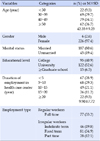Abstract
Purpose
This study is a descriptive survey to identify emotional labor and job stress recognized in the course of administrative work, and how these affect the professional quality of life of public health nurses according to the employment type.
Methods
Data was collected through a survey of public health nurses conducted from Dec. 2018 to Jan. 2019 (N=232).
Results
The emotional labor of public health nurses was 3.27 out of 5 and full-time public health nurses had the highest scores. The job stress score was moderate at 2.45 out of four. The job stress of full-time nurses was also the highest. Among the sub-divisions of professional quality of life, compassion satisfaction was 3.55 out of five, while secondary traumatic stress was moderate at 2.48 and exhaustion at 3.01. Factors affecting compassion satisfaction were shown to be employment types and exhaustion. Factors affecting secondary traumatic stress were exhaustion, job stress and emotional labor. Factors affecting exhaustion were secondary traumatic stress and compassion satisfaction.
Figures and Tables
Table 2
Participants' Scores of Emotional Labor, Job Stress, and Professional Quality of Life (N=232)

Table 3
Difference in Emotional Labor, Job Stress, and Professional Quality of Life according to Participants' Characteristics (N=232)

References
1. Ministry of Health and Welfare. Reinforcing public health to eliminate regional gaps in required medical services [Internet]. Sejong: Ministry of Health and Welfare;2018. updated 2018 October 1. cited 2019 August 2. Available from: URL http://www.mohw.go.kr/react/al/sal0301vw.jsp?PAR_MENU_ID=04&MENU_ID=0403&CONT_SEQ=346233&page=1.
2. Han YR, Lee BS, Kim B. Public health nurses' perception of their roles & duties. Journal of Korean Public Health Nursing. 2016; 30(3):526–543. DOI: 10.5932/JKPHN.2016.30.3.526.
3. Public Health Nurses Association. Status of Nursing Manpower Dynamics Survey in Health 2011. updated 2012 January 31. cited 2019 July 10. Available from: URL http://www.kphn.org/bbs/board.php?bo_table=information_2.
4. Public Health Nurses Association. Status of Nursing Manpower Dynamics Survey in Health 2018. updated 2019 January 31. cited 2019 July 10. Available from: URL http://www.kphn.org/bbs/board.php?bo_table=information_2.
5. Han SJ, Kwon MS, Yoon OS, Moon MY. Emotional labor and job stress of public health nurses. Journal of Korean Public Health Nursing. 2012; 26(2):314–327. DOI: 10.5932/JKPHN.2012.26.2.314.
6. Grandey A. Emotional regulation in the workplace: A new way to conceptualize emotional labor. Journal of Occupational Health Psychology. 2000; 5(1):95–110. DOI: 10.1037/1076-8998.5.1.95.
7. Morris JA, Feldman DC. The dimensions, antecedents, and consequences of emotional labor. The Academy of Management Review. 1996; 21(4):986–1010. DOI: 10.2307/259161.
8. Lee SR, Park JO, Park JC. Current status, risk factors, and health effect of emotional labor among workers dealing with clients. Occupational Safety and Health Research Institute;2015. Available from: https://www.043w.or.kr/www/downloadBbsFile.do?atchmnflNo=18892.
9. The National Institute for Occupational Safety and Health (NIOSH). NIOSH Numbered Publications What Is Job Stress? What are the Causes of Job Stress? 1999 DHHS (NIOSH) Publication Number 99-101. Available from: https://www.cdc.gov/niosh/docs/99-101/default.html.
10. Occupational Safety and Health Research Institute (2004). Standardization of job stress measurement scale for korean employees (the 2nd year project). Available from: http://oshri.kosha.or.kr/oshri/publication/researchReportSearch.do?mode=list&&articleLimit=10&srSearchVal=%EC%A7%81%EB%AC%B4%EC%8A%A4%ED%8A%B8%EB%A0%88%EC%8A%A4&article.offset=10.
11. Kim YH, Kim YT, Sun BY, Ko SB. Job stress and management plan of service women workers. Korean Women's Development Institute;2006. Available from: https://www.kwdi.re.kr/publications/report.do?cg1=&cg2=&s=searchAll&w=%EC%A7%81%EB%AC%B4%EC%8A%A4%ED%8A%B8%EB%A0%88%EC%8A%A4.
12. Stamm BH. The concise ProQOL manual for the Professional Quality of Life Scale 2nd Ed. [Internet]. Pocatello: the Pro-QOL.org;2010. cited April 26, 2018. Available from: https://proqol.org/uploads/ProQOL_Concise_2ndEd_12-2010.pdf.
13. Yoon SR. The relationship between emotional labor, job stress and professional quality of life in nurses working in oncology wards [master's thesis]. [Busan]: Koshin University;2017.
14. Shin HJ, Kim KH. Emotional labor and professional quality of life in Korean psychiatric nurses. Health and Social Welfare Review. 2015; 35(4):190–216. DOI: 10.15709/hswr.2015.35.4.190.
15. Song YJ. A study on the effect of emotional hardship on job satisfaction and turnover of nurses [master's thesis]. Bucheon: Catholic University;2011.
16. Kim MJ, Gu MO. The development of the stress measurement tool for staff nurses working in the hospital. Journal of Korean Academy of Nursing. 1984; 14(2):28–37. DOI: 10.4040/jnas.1984.14.2.28.
17. Kim WJ. A study on job stress and coping types for community mental health center workers [master's thesis]. Gongju: Kongju National University;2011.
18. Han SJ, Yoon OS, Kwon MS, Song MS. Comparison of emotional labor and job stress of hospital nursing staff. Korean Journal of Occupational Health Nursing. 2011; 20(1):55–64. DOI: 10.5807/kjohn.2011.20.1.055.
19. Song MR, Park KJ. Emotional labor experienced by ambulatory care nurses. Journal of Korean Academy of Nursing Administration. 2011; 17(4):451–461. DOI: 10.11111/jkana.2011.17.4.451.
20. Brotheridge CM, Grandey AA. Emotional labor and burnout: Comparing two perspectives of "people work". Journal of Vocational Behavior. 2002; 60(1):17–39. DOI: 10.1006/jvbe.2001.1815.
21. Diefendorff JM, Erickson RJ, Grandey AA, Dahling JJ. Emotional display rules as work unit norms: a multilevel analysis of emotional labor among nurses. Journal of Occupational Health Psychology. 2011; 16(2):170–186. DOI: 10.1037/a0021725.
22. Kim HG, Lee RS, Jang SN, Kim KB, Chin YR. Comparison of working conditions among non-regular visiting nurses in public health centers based on their employment types. Journal of Korean Academy of Community Health Nursing. 2018; 29(3):267–278. DOI: 10.12799/jkachn.2018.29.3.267.
23. Kim H, Kim HL. A study on occupational satisfaction and stress of visiting nurses at district health centers in Chungnam Province. Korean Journal of Occupational Health Nursing. 2011; 20(2):204–211.
24. Kim S, Kim JH, Park JY, Suh EY, Yang HJ, Lee SY, et al. Oncology nurses' professional quality of life in a tertiary hospital. Journal of Korean Clinical Nursing Research. 2010; 16(3):143–155.
25. Jeong HL, Lim KH. Effects of emergency department nurses' emotional labor on professional quality of life - Focusing on mediating effects of emotional dissonance. Journal of the Korea Academia-Industrial cooperation Society. 2016; 17(11):491–506. DOI: 10.5762/KAIS.2016.17.11.491.
26. Hooper C, Craig J, Janvrin DR, Wetsel MA, Reimels E. Compassion satisfaction, burnout, and compassion fatigue among emergency nurses compared with nurses in other selected inpatient specialties. Journal of Emergency Nursing. 2010; 36(5):420–427. DOI: 10.1016/j.jen.2009.11.027.




 PDF
PDF ePub
ePub Citation
Citation Print
Print






 XML Download
XML Download